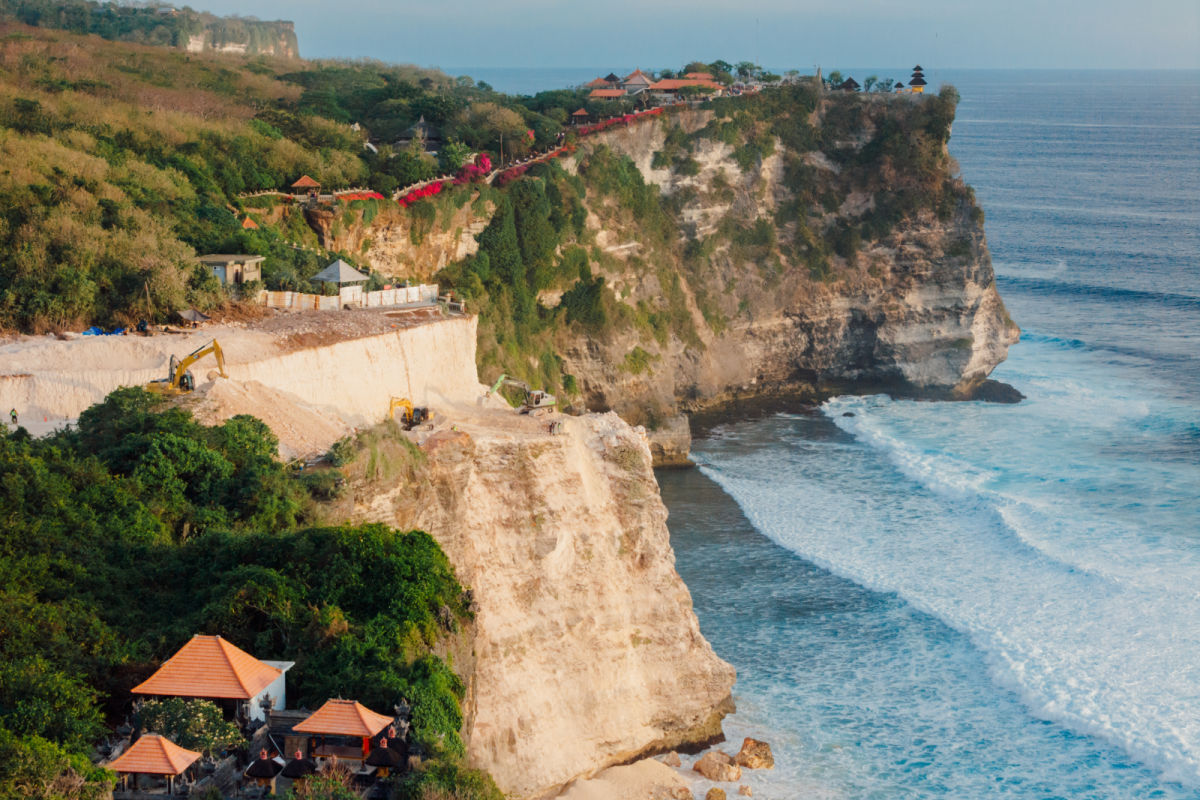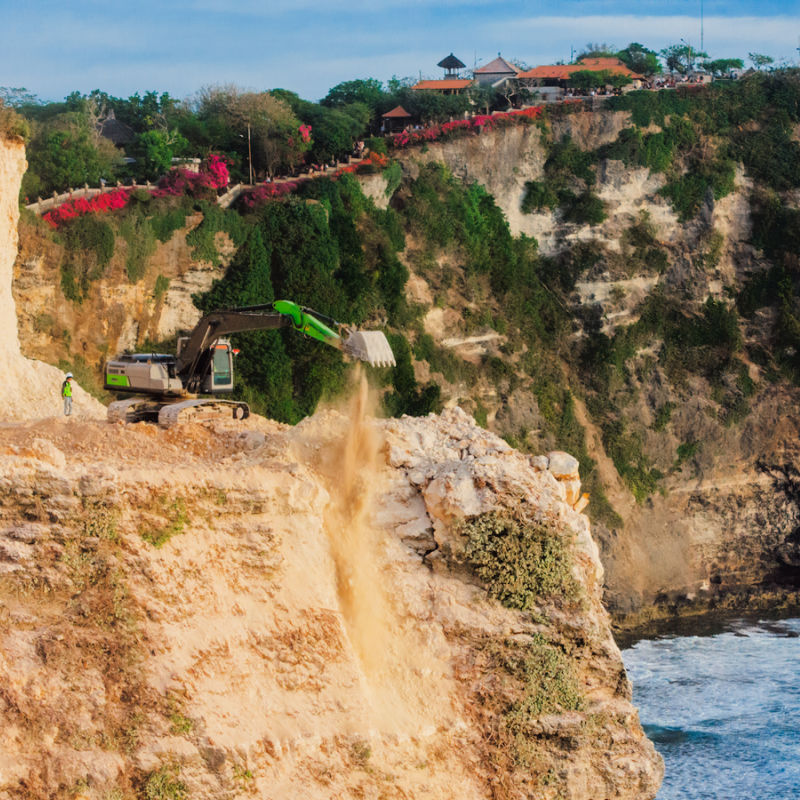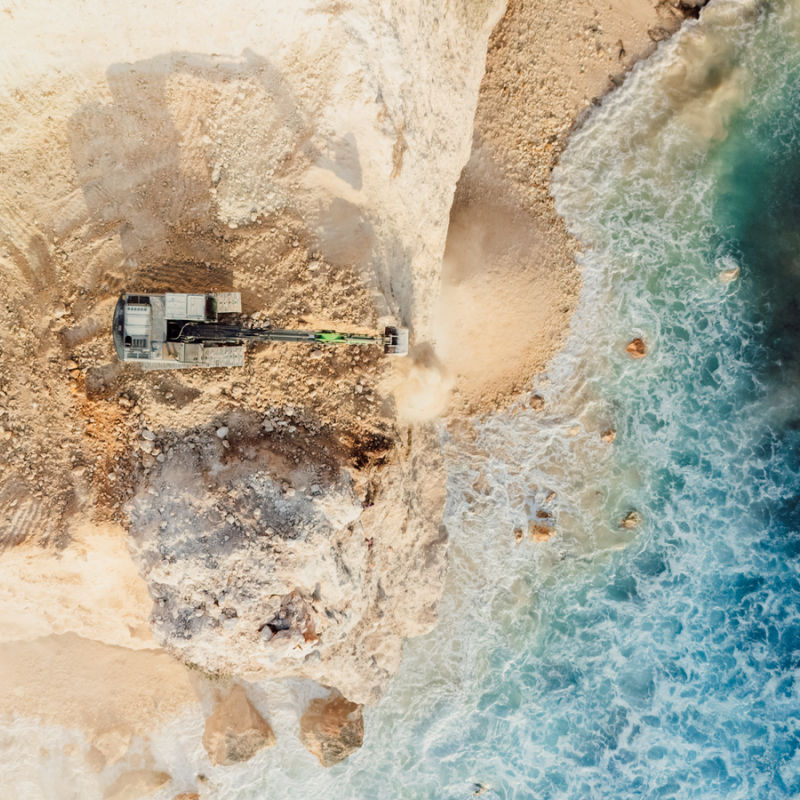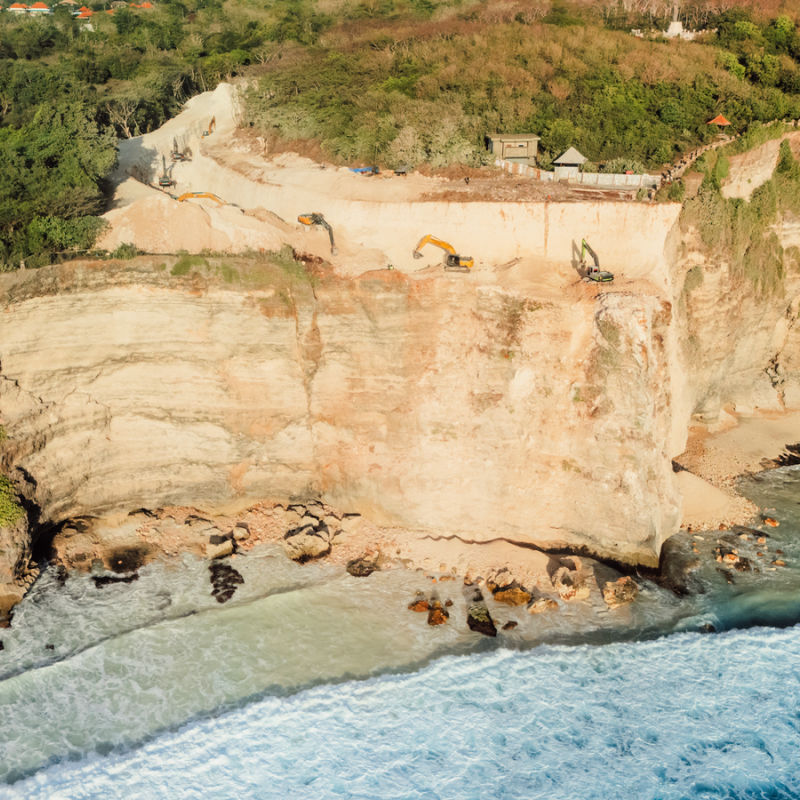The Uluwatu Sea Wall Project is one of the most contentious development initiatives in Bali right now. Three-quarters of a huge section of the Uluwatu cliffside, close to Uluwatu Temple, has been excavated to make way for what the public initially understood to be cliff stabilization work.
As construction work progressed, it became clear that the project’s scope required far more development than the public was initially aware of.

The Bali Attorney General’s Office is now investigating what is happening at the Uluwatu cliff. The Bali Attorney General’s Office, known locally as Kejagung, has called in for inquiry a number of officials at the Badung Regency Government Office and at the Badung Regency Building and Public Works Agency (PUPR) to comprehensively assess whether construction permit and license violations have taken place.
Residents have been vocal in their concerns that not only has the scope of the project changed since it was first mentioned publicly by officials, but an environmental impact assessment, known locally as an AMDAL, was potentially not completed before construction began, nor was there sufficient public consultation regarding the scope of the development.
In a press meeting, the Head of PUPR Badung, Ida Bagus Surya Suamba, confirmed that he had taken part in an examination by the Attorney General’s Office last week.
The examination was conducted based on complaints submitted regarding projects in Jimbaran Village and Pecatu Village that are suspected of damaging the environment. However, in terms of permits, Surya Suamba said that both projects have been conducted in accordance with permissions.
Suamba, who is also the Acting Secretary of Badung Regency, told reporters, “Regarding environmental destruction, if the permit is in accordance with everything but in the field there is a connection to the cliff problem, it has been processed by Satpol PP.” The Satpol PP is the local civil police service. He added, “This is what is being evaluated in relation to licensing issues.”
Essentially, the Bali Attorney General’s Office is investigating whether there have been any breaches of licenses or permits in the project development to date.
According to Suamba, the police may have to address the local community’s concerns about environmental damage as a separate issue. Suamba suggests that any suspected environmental damage likely falls outside licensing issues regarding the scope of the work.
Residents have been concerned that much debris has been dumped into the ocean, that the landscape has been totally degraded, flora has been excavated away, a local troop of monkeys displaced along with birdlife, and that there is an implication to the stability of the cliffside more broadly.

For concerned residents, the grey area now lies in whether or not the project has gone ahead without an environmental impact assessment and if so, why? It appears the project has been granted permission to go ahead without an environmental impact assessment published for public reference.
The project has been reported locally to have been given the go-ahead minus an AMDAL on the basis that the work constitutes an ‘emergency’.
With this in mind, it may be hard to prove that the project itself has caused the environmental damage or whether private contractors can be called out for negligence outside of the scope of the project as outlined in the permits.

In short, it may be difficult to prove or find evidence of environmental damage from this angle of inquiry if the environment hadn’t been assessed before the project began, irrespective of the socking scenes at the excavation site.
The Attorney General’s Office might be unlikely to find any breaches of permits if the project permits were granted via a legal loophole that bypassed the need for an environmental impact assessment in the first place.
Leaders have been steadfast in their comments that the Uluwatu Sea Wall Project is essential to stabilising the cliff under Uluwatu Temple. The reason the cliff has been excited to such a degree is to create an access road for construction vehicles to carry out the cliff conservation work.
Last month, Suamba told reporters that the project was essential, that the road was not for public use, and that it would benefit the Balinese Hindus.

Suamba said, “This road is not for the public, only for religious purposes and also for inspections related to the maintenance and checking of the cliffs of Pura Luhur Uluwatu…With this condition, of course, we will continue to try to work by preserving the local beach conditions. [Previously] there was an operator error that dumped material into the sea, we have warned them. If it is found again, we will stop it.”
He concluded, “This road is very necessary because the people, when carrying out the Melasti ceremony going down is very dangerous. While we are doing this planning, we will make it better and look very natural.”
Remove All Ads & Unlock All Articles… Sign up for The Bali Sun Premium

Plan Your Bali Holiday:
Book The Best English Speaking Drivers For Airport Transfers & Tours
Choose From Thousands of Bali Hotels, Resorts, and Hostels with Free Cancellation On Most Properties
Book Cheap Flights To Bali
Don’t Forget Travel Insurance That Covers Medical Expenses In Bali
For the latest Bali News & Debate Join our Facebook Community
SUBSCRIBE TO NEW POSTS
Enter your email address to subscribe to The Bali Sun’s latest breaking news, straight to your inbox.

Ni Kadek
Tuesday 8th of October 2024
Fake outrage from people upset that some of the limestone is getting wet, while tons of trash is being dumped into rivers that eventually flow into the sea.
I'm afraid this will become a new dumping ground for trash from the ceremonies and tourists more than anything.
Steve b
Tuesday 8th of October 2024
It's not the operators of machinery nor the supposed error of dumping thousands of tons into the see, they really think the public the little people are stupid ya. It's the no paperwork permits authorisation and environmental regulations and its the absolute corruption all the usual aspects in power the elite the greedy who deny everything with a smile they are not malu THEY HAVE NO SHAME
Exp
Thursday 10th of October 2024
@Steve b, A project run by the local gov. setting is the "standards" here for what can go wrong.
t
Tuesday 8th of October 2024
So sad to see this happening to Uluwatu, too much change and distraction going on Bali, official's and Government do not seem to care anymore.
WAYAN BO
Tuesday 8th of October 2024
Anyway world champion in self destruction.
Exp
Monday 7th of October 2024
The cliff is already vandalized and this is not reversible.
So why all the smoke and mirrors about permits and environmental impact assessment?
"Paperwork" here is mainly used as leverage to extract money in the event a "mistake" can be found. Then that is a "big problem" with only one avenue out.
All cliff damage has been done according to the plan. How else would they get their machinery down to beach level? Oh wait! They did not want to use construction equipment arriving onboard barges (weather sensitive and expensive I admit), or use huge crane from above (easier but also expensive). So then they ended on low cost excavation of soft cliff material.
In summary all this debacle is caused by motivation to save cost. I wonder who will benefit from the cost saving?